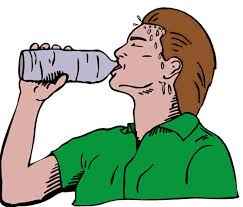| Pure Water Products |
|
October, 2025
|
|
|
Water Treatment Issues and Current Water News |
In this October Occasional you'll hear a lot about microplastics in your drinking water, plus arsenic, bacteria, chlorine and chloramine, hard water, lead, manganese, PFAS, and nitrates, plus current water news about disappointing regularatory events, drought, and pollution, and, as always, there is much, much more. |
Bottled Water may not be the cleaner choice
New study links microplastics to chronic health issues as industry spokespeople cite limitations
By Angelica Stabile
“Individuals who drink bottled water regularly ingest up to 90,000 more particles each year than those who drink mainly tap water.”
Microplastics are a known threat to overall health — and eating and drinking from plastic containers, like water bottles, could be a great offender, researchers suggest. A new study published in the Journal of Hazardous Materials analyzed 141 existing scientific papers on microplastics and nanoplastics from single-use plastic water bottles to gauge how much plastic people may be ingesting. Researchers at Concordia University in Montreal, Canada, discovered that the average person consumes 39,000 to 52,000 microplastic particles per year, according to a university press release.
Individuals who drink bottled water regularly ingest up to 90,000 more particles each year than those who drink mainly tap water, the study found.
The researchers noted that nanoplastics are especially concerning, as they’re invisible to the naked eye and smaller than 1 micron. They can also enter human cells, cross biological barriers and have the potential to reach organs and tissues, they cautioned.
“People need to understand that the issue is not acute toxicity – it is chronic toxicity,” said the lead researcher of the study.
Nanoplastics and microplastics have both been linked to serious and long-term health complications, including respiratory and reproductive issues, brain and nerve toxicity, and cancer risks.
These particles entering the bloodstream and vital organs can also cause chronic inflammation, oxidative stress on cells and hormonal disruption, according to the release.
These tiny plastic pieces emerge as bottles are made, stored, transported and broken down, and shed particles when they’re manipulated and exposed to sunlight or temperature changes, experts cautioned.
Exposure to sunlight and temperature changes can cause plastic particles to shed, experts warn.
“The long-term effects remain poorly understood due to a lack of widespread testing and standardized methods of measurement and detection,” the release stated.
Lead study author Sarah Sajedi, an environmental management expert and Ph.D. candidate at Concordia University, said in the press release that the health risks of plastic water bottles are “seriously understudied.”
“Education is the most important action we can take,” she said. “Drinking water from plastic bottles is fine in an emergency, but it is not something that should be used in daily life. People need to understand that the issue is not acute toxicity — it is chronic toxicity.”
Individuals who drink bottled water regularly ingest up to 90,000 more particles each year than those who drink mainly tap water.
The analysis did have some limitations, the researchers noted. The numerous studies used various testing methods, which means results are not always comparable. Some were also lacking in data on the size and composition of these particles.
The researchers called for further standardized testing and stronger policies to control the contamination of plastics in bottled water.
The analysis was supported by the Natural Sciences and Engineering Research Council of Canada and Concordia University.
Industry reps speak out
In January 2025, the International Bottled Water Association issued a statement related to the risk associated with microplastics and nanoplastics, pointing out that bottled water is among thousands of food and beverage products that are packaged in plastic containers.
“The bottled water industry is committed to providing consumers with the safest and highest quality healthy hydration products,” says the statement on IBWA’s website. “Micro- and nanoplastics are found everywhere in the environment — in the air, soil and water.”
“Because there are no certified testing methods and no scientific consensus on the potential health impacts of micro- and nanoplastics, the industry supports conducting additional research on this important issue.”
The FDA issued a statement on the topic in 2024, stating that “current scientific evidence does not demonstrate that levels of microplastics or nanoplastics detected in foods pose a risk to human health.”
In 2024, the FDA issued a statement on the topic, stating that “current scientific evidence does not demonstrate that levels of microplastics or nanoplastics detected in foods pose a risk to human health.”
The agency noted that it will continue to monitor research on microplastics and nanoplastics in foods and that it is “taking steps to advance the science and ensure our food remains safe.”
In a 2022 report from the World Health Organization, the agency stated that “no adverse health effects could be drawn from dietary exposure to micro- and nanoplastic particles less than 10 microns due to minimal scientific research.”
Fox News Digital reached out to the Concordia University researchers and to multiple bottled water companies for comment.
Angelica Stabile is a lifestyle reporter for Fox News Digital.
This article is truncated. See full article, with graphics, at Fox News.
Residential Removal of Microplastics from Water
Avoiding microplastics in the environment is becoming increasingly difficult. Removing them from drinking water is relatively easy.
Standard treatments for drinking water like reverse osmosis and carbon filtration do an excellent job on microplastics, so no special equipment is needed.
Reverse osmosis, which filters out particles down to 0.001 microns, is the best treatment, but standard carbon filtration also works very well. Highest removal percentages with carbon filtration are obtained with carbon block filters. The tighter the filter, the better the result, but even small end-of-faucet filters and pitcher filters are reasonably effective. Changing cartridges frequently is important.
Leading Water Issues, Old and New
by Emily McBroom and Gene Franks
The statement,”my parents drank this water for 50 years, and it never hurt them” is no longer a valid excuse for consumers to not be concerned with their water quality.—Greg Reyneke.
In an article in H2O Quality magazine, water treatment specialist Greg Reyneke (see note below) commented on recent information that has surfaced about some old water treatment issues. Below are Greg’s comments, followed by some observations of our own which suggest practical approaches to dealing with the contaminants. Greg’s comments are italicized.
Arsenic
A 2010 assessment by the Environmental Integrity Project suggests that the risk of getting cancer from drinking water containing 10 ppb of arsenic is closer to 1 in 136, almost 15 times higher than current EPA assumptions (1 in 2000). Many scientists say the increased risk of cancer in humans who drink water, inhale dust, or ingest soil contaminated with high levels of inorganic arsenic puts the chemical’s danger level in the same category as that of smoking cigarettes.
The acceptable maximum level for arsenic in drinking water, as recommended by the EPA, is just 1/5 what it was a few years ago. Removing arsenic from a small amount of drinking water is fairly easy, while point-of-entry removal is difficult and expensive. Since arsenic is mainly an ingestion issue, we recommend removing it from drinking water and practicing common sense avoidance for other water in the home. In other words, drink water from your kitchen reverse osmosis (RO) unit, not from the bathroom sink. The best drinking water treatment for arsenic is reverse osmosis. Undersink filters with iron oxide media are also effective. Whole house arsenic treatment is possible but expensive and requires considerable upkeep.
Bacteria and Waterborne Pathogens
Bacteria exist in ALL water at some level, even safe, chlorinated city water. Some bacteria are relatively “safe,” but there are other potential problems like brain-eating amoeba that have been found in certain waters. The expense and difficulty of consistent testing often means that contamination may go undiscovered for extended periods of time.
By far the best residential treatment for bacterial contamination is ultraviolet. UV was at one time used almost exclusively with well water, but because of growing concerns over the effectiveness of city water disinfection, and because of frequent “boil water” alerts, whole house UV units are now becoming common items in homes with municipal water. UV can also be used for point of use applications, but it costs so little extra to do the whole house, point of entry systems are most common. UV is a reliable technology that adds nothing objectionable to the treated water. It is easy and relatively inexpensive to maintain.
Chlorine and Chloramine
While chlorination of water is probably one of the most significant contributors to lowering the risk of waterborne illness in the USA, there are significant negative effects, such as taste and odors, corrosion, and even a correlation to the development of some cancers.
Removing chlorine or chloramine from water for the whole home or for drinking water only is best accomplished with carbon filtration. There are innumerable products to choose from, including large tank-style filters, carbon block cartridges, and even small filters built into refrigerators. Whole house filters can remove chlorine or chloramine, but tighter drinking water filters are more effective at removing other chemical contaminants that might be present. An excellent residential treatment plan is a whole house carbon filter to provide chlorine/chloramine-free water for bathing and general household purposes, and a drinking water unit, either a tight carbon block filter or reverse osmosis unit, for drinking water only. In general, chloramine is much harder to remove than chlorine. Chloramine removal filters are larger and use better quality carbon (catalytic carbon) to do the job.
Hard Water Scale and Soap Interactions
While many people might consider hard water to be a simple aesthetic issue, it really is bigger than that. Hard water is a significant drain on a family’s monthly budget and has a decidedly negative impact on the planet due to increased heating and cleaning expenses, along with premature appliance failure. Consumers are clamoring for low-salt and no-salt solutions to their hard water problems that “waste” a minimum amount of water.
While there is no substitute for the conventional salt-based ion exchange water softener, salt-free alternatives, especially TAC (Template Assisted Crystallization) units, are growing in popularity fast. While TAC units don’t do some of the things softeners do, they have the advantage of requiring no salt, electricity, or connection to a drain. They don’t use water for regeneration or add salt to wastewater.
Lead
While Flint, Michigan captured the imagination of the nation, lead can also be found at some level in other areas. In 2017, 779 Texas schools (about 71%) were reported to have lead in their drinking water, according to an analysis of testing data by Environment Texas Research and Policy Center. Lead is a potent neurotoxin, affecting the way children learn, grow, and behave It can cause problems that will persist into adulthood.
Lead is a tricky issue, because lead in drinking water often comes from the pipes inside the home itself, making a “whole house” filter for lead pointless. Nevertheless, growing evidence shows that infrastructure issues, old lead city water pipes in particular, are adding lead to water coming into homes. Lead can be removed by ion exchange and by special carbon block filters with added resins, but reverse osmosis is the best treatment for drinking water. As with many contaminants, lead is mainly an ingestion issue, so having a good reverse osmosis unit in the kitchen is the most practical treatment.
Manganese
The serious health risks of consuming water containing manganese have been overlooked for far too long. Long-term consumption of even low levels are now related to complications involving alterations in neurotransmitter and enzyme levels in the brain that can cause nerve damage, brain changes, hormone alteration, and possibly even the proliferation of certain cancers.
Manganese is normally a well water issue, but we increasingly hear reports of manganese in water from central suppliers, especially small water systems. Manganese, regardless of the source, is a significant aesthetic issue, causing odors and dark stains, and it is now being regarded as a health issue as well. Whole house treatments can be complicated, but they can also be as simple as a conventional water softener or a backwashing filter. For drinking water, reverse osmosis assures manganese-free water.
Perfluorinated Compounds (PFC, PFOS, PFOA)
Perfluoroalkyls are not natural, and PFOA and PFOS are the two types that have typically been found in the largest amounts. These substances are unique because they repel oil, grease, and water – meaning they have been used to help produce countless convenient modern products. Exposure levels of these chemicals can already be found in the blood of most Americans. Health risks from exposure to these chemicals include hormone disruption, fertility issues, and even certain cancers.
Although treatment for perfluorinated compounds in municipal systems can be complex, carbon filtration for whole house and reverse osmosis for drinking water have been found to provide significant reduction for homes.
Nitrates
One other issue we would like to add to the list of regulated contaminants that should be taken more seriously is nitrates. There is growing evidence that nitrate contamination is becoming much more common, not only in well water but also in city water supplies. The long-standing EPA allowable amount of 10 parts per million may be way too lenient. Although nitrates can be removed with ion exchange, the best and easiest way to provide nitrate-free drinking water is with an undersink RO unit in the home. Whole house carbon filters are not effective with nitrates.
Conclusion
Of the issues discussed, whole house treatments are practical for bacteria and hardness. For city water with chlorine, chloramine, and general chemical issues, including PFAS, an appropriately designed and sized whole house carbon filter is recommended. For drinking water issues like lead, nitrates, and arsenic, an undersink reverse osmosis unit is the treatment of choice. A good undersink RO unit covers virtually all drinking water issues. It includes carbon block filters for chemical reduction and a very tight membrane that strains out lead, arsenic, fluoride, nitrates, sodium, and other undesirables.
Reference: Greg, Reyneke, “It’s Up to You,” H2O Quality (a publication of the Texas Water Quality Association), Winter, 2019. pp. 10-12. See also www.gregknowswater.com .
|
Water News
Water News for October of 2025

Water News for October 2025
Raw Sewage Taints the Delaware River
Philadelphia discharges an incredible 12.7 billion gallons of raw, diluted sewage into the Delaware River’s watershed each year according to a new report. The Philadelphia Inquirer.
Amazing Recovery of the Klamath River after Hydroelectric Dam Removal
The final of four hydroelectric dams was removed last year from the Klamath River, in the largest project of its kind in US history. The following July, 28 teenage tribal representatives completed a 30-day journey that spanned roughly 310 miles (500km) from the headwaters in the Cascades to the Pacific. They were the very first to kayak the entirety of the mighty river in more than a century. The Guardian.
Water Projects Ordered Cancelled May Not Be Cancelled
A week after the White House signaled its intention to “immediately” pause or cancel $11 billion worth of water projects in 12 states that lean politically toward Democrats, it’s unclear what — if any — work might be affected.
The Army Corps of Engineers, which would oversee those projects, lacks the authority to cancel work authorized by Congress, multiple former corps officials said.
A former corps official, who is now senior adviser at Dawson and Associates, a Washington firm specializing in federal water regulation and environmental permitting, said he doesn’t know of any funds being paused or redirected away from blue-state projects. E&E News.
Severe Drought in Washington
Unprecedent drought conditions in Washington's Yakima River Basin have made necessary a population-wide total ban on irrigation and lawn or garden watering. This is Washington's third straight drought year in a row. Seattle Times.
Congresswoman Seeks Release of PFAS Report
A drinking water report studying the toxicity of perfluorononanoic acid, or PFNA, from the U.S. Environmental Protection Agency finalized in mid-April has yet to be released to the public, sparking concerns from Representative Chellie Pingree.
PNFA is a type of per- and polyfluoroalkyl substance, or PFAS. PFAS encompass thousands of man-made chemicals found in everyday items like non-stick cookware, firefighting foams, grease-resistant food wrappers, water-resistant clothing and other items. PFAS, known as "forever chemicals" because of the long time it takes the chemicals to break down, can cause harm in high exposure amounts.
During the breakdown process, PFAS can leach into the soil and water supply. These chemicals also threaten the water supply when products containing them are dumped onto the ground or into lakes and rivers. A 2023 study from the U.S. Geological Survey found that PFAS are present in the tap water of nearly half of U.S. homes.
On October 16, Pingree, from Maine, sent a letter to EPA Administrator Lee Zeldin asking him why the report has yet to be released and who is responsible for its delay, among other questions. Newsweek
After Decades, Camp LeJeune Water Scandal Still On Hold in Congress
Decades after Marines and families at North Carolina's Camp Lejeune bathed and drank in poisoned water, the law meant to bring them justice has stalled. The 2022 Camp Lejeune Justice Act — intended to finally allow victims their day in court — has instead become mired in legal backlogs and procedural fights.
As medical bills mount from lifetimes of chronic illness and loved ones pass away, families say Washington’s delays have turned a promise of justice into yet another bureaucratic waiting game. Fox News for full article.
Another Chemical Industry Lobbyist Being Appointed to EPA
The US Senate is poised to approve Donald Trump’s nomination of an industry lobbyist to lead the US Environmental Protection Agency’s chemical safety office. If the nominee, Douglas Troutman, is confirmed, the top four toxics office positions at the EPA will be held by former chemical industry lobbyists, raising new fears about the health and safety of the American public, consumers and workers, campaigners say.
“The lunatics are running the asylum, and industry is firmly in charge of chemical safety,” said Scott Faber, vice-president of government affairs for the Environmental Working Group non-profit, which lobbies on chemical safety issues. “They will stop at nothing to reverse the progress that we’ve made in recent years on toxic chemicals.” The Guardian
Politics and the Waters of the United States
In 2023, the U.S. Supreme Court narrowed the definition of the Waters of the United States in the case Sackett v. Environmental Protection Agency. The result of that decision is estimated to have eliminated more than half of the nation's wetland acres eligible for protections by the Clean Water Act. Iowa Public Radio.
Nobel Prize for Chemistry
Susumu Kitagawa, Richard Robson and Omar Yaghi were awarded the Nobel Prize in Chemistry 2025.Using techniques that they discovered, other scientists are applying their techniques to applications that include separating PFAS from water, breaking down traces of pharmaceuticals in the environment, capturing carbon dioxide or harvesting water from desert air. Water Online.
Lead Pipe Removal Lags As Federal Government Fails to Release Funds
The Trump administration is months behind schedule in distributing an estimated $3 billion to remove and replace lead water pipes, delaying infrastructure projects critical to protecting people from the toxic heavy metal. The 2021 infrastructure law included $15 billion to help fund the replacement of millions of lead-based drinking water pipes nationwide. The money has been divvied up and distributed in tranches to states each year, typically in the spring.
But nearly five months after EPA announced other funding this year for water projects through the State Revolving Funds, money for lead pipes remains held up. At least three states with a large number of lead pipes — Wisconsin, Michigan and Massachusetts — said the delay could push back construction schedules for pipe replacement projects. Politico Pro
Heavy Rains Increase Microplastics in Water
Research conducted in India and South Africa demonstrates a sharp increase in microplastics in water after heavy rains. Yahoo News.
Microplastics Are Concentrated in Brain Tissue
A new study at the University of New Mexico Health Sciences, which examined the bodies of 47 cadavers, found microplastics in the brain are much higher in concentration than other parts of the body.The worst part is that this concentration has increased by 50% in only eight years. Researchers found 4,800 micrograms of microplastics per gram of brain tissue, the equivalent of a plastic spoon in total. Though the exact impact is unknown with these microplastics, One of the researchers said, “We start thinking that maybe these plastics obstruct blood flow in capillaries. There’s the potential that these nanomaterials interfere with the connections between axons in the brain. They could also be a seed for aggregation of proteins involved in dementia. We just don’t know.” Yahoo News.
|
|
Places to visit for additional information:
|
|
|
|
|
|





